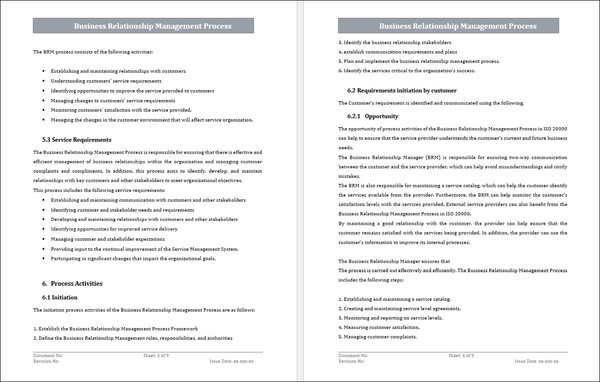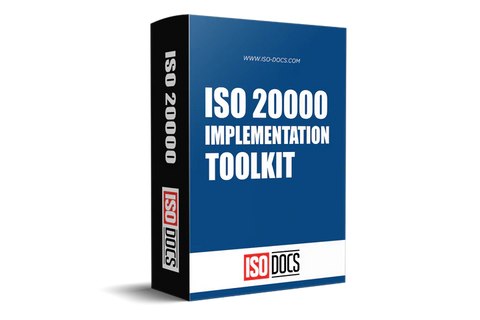Business Relationship Management (BRM)
What is Business Relationship Management (BRM)?
Business Relationship Management (BRM) is a process within ISO 20000 that helps organizations manage their relationships with other businesses. It is a crucial part of any business continuity plan, ensuring that vital relationships are identified and maintained.

The process of BRM involves four main steps:
1. Identifying business partners
To identify business partners, the first step is to understand the needs of the enterprise. Once the enterprise understands its needs, it can identify potential business partners to help meet those needs. To select the best business partners, the enterprise must consider several factors, including the company's size, financial stability, reputation, and ability to meet the enterprise's needs.
Once the enterprise has selected its business partners, it must manage the relationship to ensure that it benefits both parties. BRM includes setting expectations, negotiating contracts, and monitoring performance. The enterprise must also support its business partners, such as training and marketing assistance.
2. Identifying the needs of each business partner
Business relationship management aims to optimize an organization’s value from business partners through developing and maintaining relationships.”
To optimize value from business partners, it is essential to identify the needs of each business partner. This can be done through several methods, such as interviews, surveys, or focus groups. Once the business partner’s needs are identified, developing a mutually beneficial relationship that meets those needs is essential. The final step is to maintain the relationship through ongoing communication and feedback.
By following these steps, organizations can ensure they get the most value from their business partners.
3. Develop plans to meet those needs
The business relationship management process helps you develop plans to meet your customers’ needs. It is a cycle that begins with understanding the customer’s needs and ends with providing them with the products or services they need.
• The first step in the process is to understand the customer’s needs. This can be done through research, surveys, or interviews. Once you know what the customer needs, you can begin developing plans to meet those needs.
• The next step is to develop plans to meet the customer’s needs. This includes acquiring products or services that meet the customer’s needs and creating a marketing strategy to reach the customer.
• The last step in the process is to provide the customer with the products or services they need. This includes delivering the products or services to the customer and providing customer support.
4. Managing and maintaining the relationship
BRM is the process of managing and maintaining the relationships between businesses. This includes all aspects of the relationship, from communication to agreements and contracts.
BRM is essential because it helps businesses keep track of their relationships and maintain a positive relationship with their partners. Companies can avoid potential problems and open communication channels by managing the relationship.
The BRM process can be divided into four main stages:
1. Initiation: This is the stage where businesses first establish a relationship. This can be done through networking, meetings, or other events.
2. Development: This stage is where businesses work on developing the relationship further. This can involve communication, agreeing on goals and objectives, and working on joint projects.
3. Management: This stage is about managing the relationship's day-to-day aspects. This can include solving problems, handling financial transactions, and maintaining communication.
5. Termination: This stage is where businesses end their relationship with each other. This can be done for various reasons, such as one business no longer needing the other's services or a change in direction.
Why is Business Relationship Management Important?

Business Relationship Management (BRM) is a strategic process that enables organizations to optimize business value from their technology investments. BRM plays a vital role in ensuring that technology investments are aligned with business goals and objectives.
An effective BRM program helps organizations to:
• Define and document business goals and objectives
• Understand the impact of technology decisions on business goals and objectives
• Select the right technology investments
• Manage and optimize the value of technology investments
• Communicate the value of technology investments to business stakeholders
• Ensure that technology investments are aligned with business goals and objectives.
How to implement Business Relationship Management?
Business Relationship Management (BRM) is a relatively new concept; it’s been defined as "a strategic process that focuses on developing and maintaining relationships with key stakeholders to achieve organizational objectives."
So, how can BRM be implemented in an ISO 2000 environment? Here are four steps to get you started:
- Define the scope of your BRM initiative.
- Identify the key stakeholders involved in your BRM efforts.
- Develop a plan for engaging with each of these critical stakeholders.
- Implement your BRM plan and track the results.
Following these steps ensures that your BRM initiative is appropriately scoped, planned, and executed.
The benefits of Business Relationship Management
Organizations must build and nurture relationships with their business partners to succeed. This is where Business Relationship Management (BRM) comes in. BRM is a process that helps organizations to understand, manage, and optimize their relationships with their business partners.
BRM has many benefits, including:
- Improved communication and collaboration between the organization and its business partners.
- Better align the organization's goals and objectives with its business partners.
- An improved understanding of the organization's business partners and their needs.
- Improved ability to identify and capitalize on opportunities for business partner cooperation.
- Better management of expectations between the organization and its business partners; and
- Improved overall efficiency and effectiveness of the organization's business relationships.
However, organizations that can effectively implement BRM strategies will likely see significant benefits in their business relationships. These benefits can include improved communication, collaboration, and alignment; increased efficiency and effectiveness; and enhanced trust, loyalty, and satisfaction.



